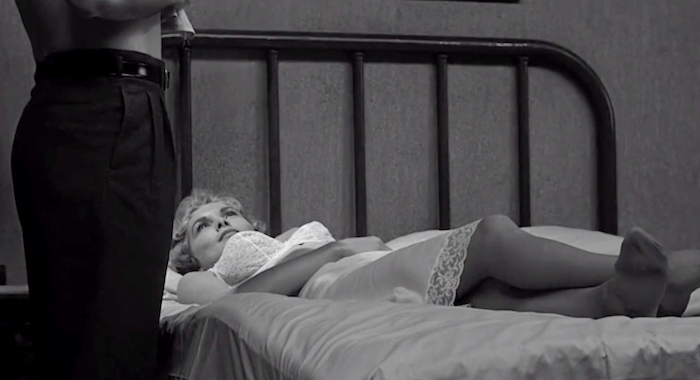The Smackdown panel is meeting this Sunday to finalize the voting and record our conversation. All five films are available on either YouTube or Amazon but for Dark at the Top of the Stairs which you can watch on the link included below. Watch the movies and vote!
While you wait for the Smackdown and its Podcast, we thought we'd do a little exercize we haven't done in a while. Let's look at how the filmmakers introduce these characters within the overall stories. Bear in mind that these aren't the lead characters, so theroetically they don't have to be introduced in a "stop and look at this person!"" kind of way. But were the filmmakers underlining their entrances, preparing you to embrace an future-Oscar-nominated-star-turn, or just going about telling the stories?
Let's investigate in the order they show up in their movies...

-You never did eat your lunch did you?
-I better get back. These extended lunch hours give my boss extra acid.
One minute in, directly after opening credits, Janet Leigh in Psycho
Marion Crane is the first character we see in Psycho and from an prurient angle, no less. That's a nasty little complicity trick since Hitchcock has already set us up as Norman Bates like in our own peeping. This is not a typical "star" entrance but if Leigh hadn't been a star already before Psycho, this post-coital opening scene would have instantly made her one.

-Morning, children.
-Morning, momma.
Three and a half minutes in we meet Shirley Knight in The Dark at the Top of the Stairs
This is an extremely casual entrance for a character who will later hijack the movie for two long stretches. Delbert Mann and his cinematographer don't single her out at all, initially, treating her exactly the same as her younger brother. It's only the dialogue and a cut to medium two-shot that suggests she'll be more important since the mother, concerned that she's reading the love letters of Robert Browning stops for a moment, reflective ."We've never talked about grown-up things, have we?" she asks. Knight never looks up at her mother in this brief scene, replying that the girls at school do talk about such things. But now we know they'll definitely be 'grown-up things' for this young girl to cope with during the running time.

Lord love a duck, A WOMAN!
Almost 44 minutes in... Glynis Johns in The Sundowners
Okay, here at last we get a typical "star" entrance. The movie star leads ring the bell at a bar/hotel and wait. We get a shot of a door -- why is no one there? -- and Glynis Johns pops through with manic energy, her face lighting up when she sees it's a whole family (there's mostly only working men in this remote town). The scene only lasts for a minute but Glynis never stops talking, rarely pausing to let her new guests even answer her questions. If The Sundowners had been a dull movie she could have still snagged a nomination, a la Cold Mountain, merely for livening things up. But since the movie is already lively, she's more like additional comic relief. She gets full closeups immediately, too, so the filmmaking team wants you to take note -- "LOOK, IT'S THE DELIGHTFUL GLYNIS JOHNS."


....Oh and Clara. Clara Dawes, our overseer.
Exactly 44 minutes in... Mary Ure in Sons and Lovers
The screenplay warns us that Clara Dawes wil be important since we hear her name four or five times directly before meeting her, and it's usually spoken with some insinuation because the "Mrs" and "Miss" which precedes it keeps changing -- so we know before meeting her that she's either married or divorced or somewhere inbetween. Our protagonist Paul (Dean Stockwell) is touring the facilities at his new job and being introduced to the staff, which ends with her. The film cuts from a longshot to this medium three-shot, further emphasizing her importance, and then she moves to the foreground. Despite the edit and the dialogue the scene starts off rather non-chalantly but every few seconds it takes it up a notch. The dialogue shifts to pointed and tetchy -- she's a feminist and suffragette and the male manager obviously dislikes her. If we doubted she was important to the film (we didn't), director Jack Cardiff, dispels all 'expendable character' doubts. Her introduction ends with a silent and intense zoom-in closeups, his & hers, which the movie hasn't been deploying up until then. We're meant to be curious and to understand that Paul is instantly fascinated.


Keep reading, honey.
One hour and 15 minutes in... Shirley Jones in Elmer Gantry
And one more STAR entrance. There's practically a whole movie about a rise to fame wrapped up before Shirley's Jezebel arrives to turn the movie on its head. She's introducedwith her back to the camera as her coworkers in the brothel read a newspaper article about Elmer Gantry. She recognizes the name, and we get a purposefully sexual close-up, her face through her stocking. After which she launches into a blue and raunchy tale about Gantry seducing her. "He rammed the fear of God into me so fast i never heard my old man's footsteps!". The movie completely pivots on her. She's not a lead but the catalyst for the fall from grace of act two, and the movie lets you know it all right there in her decadent mini monologue. If this were a musical it'd be the boisterous act two opener to get you hyped back up on the show after intermission.
Do you ever think about the way characters are introduced onscreen and how that affects our story expectations?